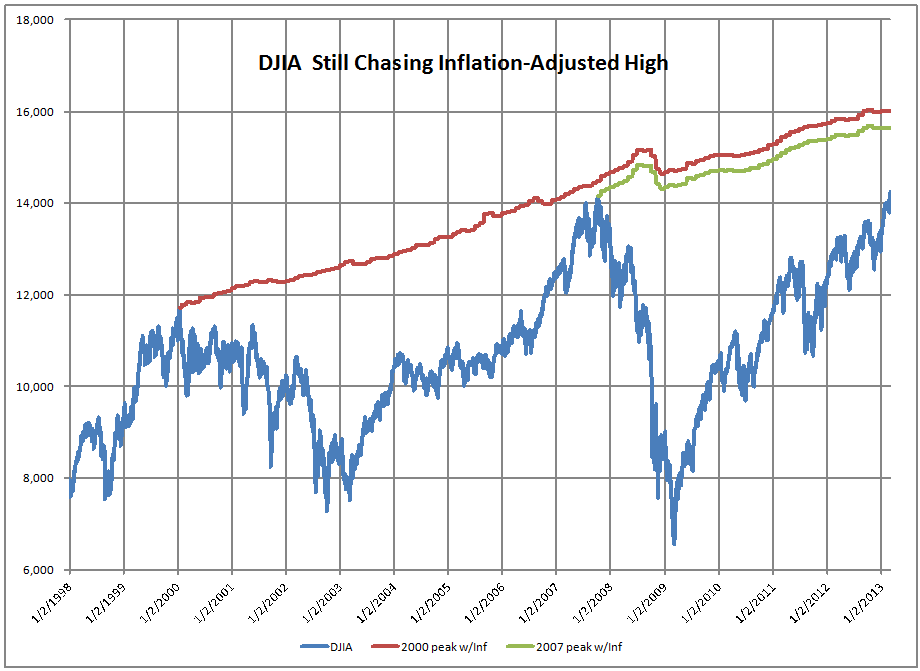So the DJIA has hit a new nominal high?? Big deal.? It has not yet eclipsed its inflation adjusted high, as is noted by this article at Bloomberg, where they said:
None of this is to say don?t invest in stocks. Nor is it to say a bubble has formed, like the technology boom of the late 1990s and the housing-fueled run-up of the mid-2000s. The evidence may even point in the opposite direction on this score: The price-to-earnings ratio — what it costs to buy a dollar of a company?s profit — for stocks in the Standard & Poor?s 500 Index is 16 percent below the level at the end of 2009.
The same goes for the Dow, which has more than doubled in four years, yet its valuation is 15 percent below the 20-year average. When adjusted for inflation, moreover, the Dow is still 9 percent below the previous all-time high hit on Oct. 9, 2007. In other words, stocks are still a bargain, historically speaking.?[Emphasis mine]
Sorry, but that’s not true, the Dow is still 12 percent below the inflation-adjusted all-time high hit on Jan. 14, 2000.? Have a look at this graph:
People forget how badly the DJIA, much less the S&P or NASDAQ overshot in 2000 from tech speculation and loose monetary policy from the Fed to cover for Y2K.
Here’s another graph to express the same idea:
Yes, there may have been a ~2% dividend over the last fifteen years, so the DJIA with dividends beat inflation by a little.? Bonds did a lot better.
All I want to say is that there is little reason for excitement over new nominal highs in the DJIA.? Also, it is a weird average, and gives IBM too much weight.? There is a better way to create a megacap index as I pointed out in the prior link.
So take a chill pill, and realize that? the DJIA is a weird index, still behind inflation-adjusted highs, at a time when profit margins are at all time highs.? This is not sustainable, and long-term valuation measures like the Q-ratio and CAPE10 indicate a market 20% or so overvalued.
So to all I say take defensive measures.? Of course things can go higher, but markets were a lot lower in 2002 than in 1999.



For the past few weeks I have been reviewing my buy list. Last week I started moving to a larger cash %.
How do Q-ratio and CAPE10 look compared to 1999, 2002, 2007, 2008?
What type of defensive measures are you thinking of? Cash, Gold? Defensive and/or high dividend stock? Other?
You should ideally be looking at real (inflation adjusted) total returns.
Since Dividends and inflation are each ~2%, they cancel each other out, so nominal returns are approximately what real total returns look like.
Actually, I don’t have to look at real returns. I can look at the stock price, and ask the question how does the value of buying now compare to the value of buying then. There are some differences, but the q-ratios and CAPE10 are high for 2000, 2007, and 2013. 2000 was the worst, though.
Of course, these charts use the government’s inflation figures. Politicians don’t think you spend money to eat food, or use energy, or things like that. I know the Shadowstats guy’s numbers are sort of dodgy but that would be a chart to make us all cry.